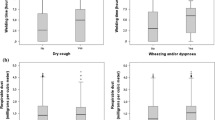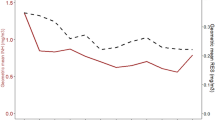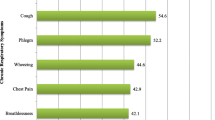Abstract
Purpose
Welding fume consists of metal fumes, e.g., manganese (Mn) and gases, e.g., ozone. Particles in the respirable dust (RD) size range dominate. Exposure to welding fume could cause short- and long-term respiratory effects. The prevalence of work-related symptoms among mild steel welders was studied, and the occupational exposure to welding fumes was quantified by repeated measurements of RD, respirable Mn, and ozone. Also the variance components were studied.
Method
A questionnaire concerning airway symptoms and occupational history was answered by 79 % of a cohort of 484 welders. A group of welders (N = 108) were selected and surveyed by personal exposure measurements of RD and ozone three times during 1 year.
Results
The welders had a high frequency of work-related symptoms, e.g., stuffy nose (33 %), ocular symptoms (28 %), and dry cough (24 %). The geometric mean exposure to RD and respirable Mn was 1.3 mg/m3 (min–max 0.1–38.3 mg/m3) and 0.08 mg/m3 (min–max <0.01–2.13 mg/m3), respectively. More than 50 % of the Mn concentrations exceeded the Swedish occupational exposure limit (OEL). Mainly, low concentrations of ozone were measured, but 2 % of the samples exceeded the OEL. Of the total variance for RD, 30 and 33 % can be attributed to within-worker variability and between-company variability, respectively.
Conclusions
Welders had a high prevalence of work-related symptom from the airways and eyes. The welders’ exposure to Mn was unacceptably high. To reduce the exposure further, control measures in the welding workshops are needed. Correct use of general mechanical ventilation and local exhaust ventilation can, for example, efficiently reduce the exposure.

Similar content being viewed by others
References
Antonini JM (2003) Health effects of welding. Crit Rev Toxicol 33:61–103
Antonini JM, Santamaria AB, Jenkins NT, Albini E, Lucchini R (2006) Fate of manganese associated with the inhalation of welding fumes: potential neurological effects. Neurotoxicology 27:304–310
Beckett WS (1996) Industries associated with respiratory diseases. In: Harber P, Schenker MB, Balmes JR (eds) Welding: occupational and environmental respiratory diseases. Mosby, St. Louis, pp 704–717
Blomqvist A, Duzakin-Nystedt M, Ohlson CG, Andersson L, Jönsson B, Nielsen J, Welinder H (2005) Airways symptoms, immunological response and exposure in powder painting. Int Arch Occup Environ Health 78:123–131
Boelter FW, Simmons CE, Berman L, Scheff P (2009) Two-zone model application to breathing zone and area welding fume concentration data. J Occup Environ Hyg 6:298–306
Boojar MM, Goodarz F (2002) A longitudinal follow-up of pulmonary function and respiratory symptoms in workers exposed to manganese. J Occup Environ Med 44:282–290
Bowler RM, Roels HA, Nakagawa S, Drezgic M, Diamond E, Park R et al (2007) Dose-effect relationships between manganese exposure and neurological, neuropsychological and pulmonary function in confined space bridge welders. Occup Environ Med 64:167–177
Drexler H, Schaller KH, Nielsen J, Weber A, Weihrauch M, Welinder H, Skerfving S (1999) Efficacy of measures of hygiene in workers sensitised to acid anhydrides and the influence of selection bias on the results. Occup Environ Med 56:202–205
Ellingsen DG, Dubeikovskaya L, Dahl K, Chashchin M, Chashchin V, Zibarev E, Thomassen Y (2006) Air exposure assessment and biological monitoring of manganese and other major welding fume components in welders. J Environ Monit 8:1078–1086
Ewing W, Harris M (2005) Manganese and welding fume. The AIH Diplomate, issue 05–2
Ferris BG (1978) Epidemiology standardization project (American thoracic society). Am Rev Respir Dis 118:1–120
Fitsanakis VA, Au C, Erikson KM, Aschner M (2006) The effects of manganese on glutamate, dopamine and gamma-aminobutyric acid regulation. Neurochem Int 48:426–433
Flynn MR, Susi P (2010) Manganese, iron, and total particulate exposures to welders. J Occup Environ Hyg 7:115–126
Flynn MR, Susi P (2012) Local exhaust ventilation for the control of welding fumes in the construction industry—a literature review. Ann Occup Hyg 56:764–776
Furbee B (2011) Welding and parkinsonism. Neurol Clin 29:623–640
Goller JW, Paik NW (1985) A comparison of iron oxide fume inside and outside of welding helmets. Am Ind Hyg Assoc J 46:89–93
Han D-H (2002) Correlations between workplace protection factors and fit factors for filtering facepieces in the welding workplace. Ind Health 40:328–334
Hobson A, Seixas N, Sterling D, Racette BS (2011) Estimation of particulate mass and manganese exposure levels among welders. Ann Occup Hyg 55:113–125
HSE (2006) Exposure measurement: air sampling. COSHH essentials general guidance G409. Health and safety executive, London. Available as http://www.hse.gov.uk/pubns/guidance/g409.pdf. Accessed 27 Nov 2012
IARC (1990) Monographs on evaluation of carcinogenic risks to humans. Vol. 49: chromium, nickel and welding. IARC Press, Lyon, France
Isaxon C, Dierschke K, Pagels J, Löndahl J et al (2013) A novel system for source characterization and controlled human exposure to nanoparticle aggregates generated during gas–metal arc welding. Aerosol Sci Technol 47:52–59
IVL Svenska Miljöinstitutet AB (2006) Krom och mangan vid svetsning—exponering och behov av åtgärder. IVL Rapport B1675. [Swedish Environmental Research Institute (2006) Chromium and manganese during welding–exposure and need of measures]
Janssen LL, Nelson TJ, Cuta KT (2007) Workplace protection factors for an N95 filtering facepiece respirator. J Occup Environ Hyg 4:698–707
Jönsson LS, Nielsen J, Broberg K (2011) Gene expression analysis in induced sputum from welders with and without airway-related symptoms. Int Arch Occup Environ Health 84:105–113
Jönsson LS, Tinnerberg H, Jacobsson H, Andersson U, Axmon A, Nielsen J (2013) Exposure to particles and ocular symptoms in welders. A study of dose-response relationship. Int Arch Occup Environ Health (in preparation)
Klos KJ, Chandler M, Kumar N, Ahlskog JE, Josephs KA (2006) Neuropsychological profiles of manganese neurotoxicity. Eur J Neurol 13:1139–1141
Korczynski RE (2000) Occupational health concerns in the welding industry. Appl Occup Environ Hyg 15:936–945
Larsson B, Karlsson J-E, Nielsen J (2007) Respiratory and ocular symptoms in workers exposed to potassium aluminium-tetrafluoride soldering flux. Int Arch Occup Environ Health 80:627–633
Lehnert M, Pesch B, Lotz A et al (2012) Exposure to inhalable, respirable, and ultrafine particles in welding fume. Ann Occup Hyg 56:557–567
Liu SA, Hammond SK, Rappaport SM (2011) Statistical modeling to determine sources of variability in exposures to welding fumes. Ann Occup Hyg 55:305–318
Meeker JD, Susi P, Flynn MR (2007) Manganese and welding fume exposure and control in construction. J Occup Environ Hyg 4:943–951
Nemery B (1990) Metal toxicity and the respiratory tract. Eur Respir J 3:202–219
Peretz C, Goldberg P, Kahan E, Grady S, Goren A (1997) The variability of exposure over time: a prospective longitudinal study. Ann Occup Hyg 41:485–500
Rappaport SM, Weaver M, Taylor D et al (1999) Application of mixed models to assess exposures monitored by construction workers during hot processes. Ann Occup Hyg 43:457–469
Roels H, Lauwerys R, Buchet JP, Genet P, Sarhan MJ, Hanotiau I, de Fays M, Bernard A, Stanescu D (1987) Epidemiological survey among workers exposed to manganese: effects on lung, central nervous system, and some biological indices. Am J Ind Med 11:307–327
Sarić M, Piasek M (2000) Environmental exposure to manganese and combined exposure to gaseous upper respiratory irritants: mechanism of action and adverse health effects. Rev Environ Health 15:413–419
Schoonover T, Conroy L, Lacey S, Plavka J (2011) Personal exposure to metal fume, NO2, and O3 among production welders and non-welders. Ind Health 49:63–72
Sferlazza SJ, Beckett WS (1991) The respiratory health of welders. Am Rev Respir Dis 143:1134–1148
Sharifian SA, Loukzadeh Z, Shojaoddiny-Ardekani A, Aminian O (2011) Pulmonary adverse effects of welding fume in automobile assembly welders. Acta Med Iran 49:98–102
Smargiassi A, Baldwin M, Savard S, Kennedy G, Mergler D, Zayed J (2000) Assessment of exposure to manganese in welding operations during the assembly of heavy excavation machinery accessories. Appl Occup Environ Hyg 15:746–750
Susi P, Goldberg M, Barnes P et al (2000) The use of a task-based exposure assessment model (T-BEAM) for assessment of metal fume exposures during welding and thermal cutting. Appl Occup Environ Hyg 15:26–38
Swedish Work Environment Authority (2011) AFS 2011:18. Occupational exposure limits, Stockholm
Taube F (2013) Manganese in occupational arc welding fumes–aspects on physicochemical properties, with focus on solubility. Ann Occup Hyg 57:6–25
Temel O, Sakar Coşkun A, Yaman N, Sarioğlu N, Alkaç C, Konyar I, Ozgen Alpaydin A, Celik P, Cengiz Ozyurt B, Keskin E, Yorgancioğlu A (2010) Occupational asthma in welders and painters. Tuberk Toraks 58:64–70
Wallace M, Shulman S, Sheehy J (2001) Comparing exposure levels by type of welding operation and evaluating the effectiveness of fume extraction guns. Appl Occup Environ Hyg 16:771–779
Wambach PF (2002) Variation in exposure levels for high hazard frequently monitored agents. AIHA J 63:421–429
Wastensson G, Sällsten G, Bast-Pettersen R, Barregard L (2012) Neuromotor function in ship welders after cessation of manganese exposure. Int Arch Occup Environ Health 85:703–713
Wolf C, Pirich C, Valic E, Waldhoer T (1997) Pulmonary function and symptoms of welders. Int Arch Occup Environ Health 69:350–353
Zeidler-Erdely PC, Erdely A, Antonini JM (2012) Immunotoxicology of arc welding fume: worker and experimental animal studies. J Immunotoxicol 9:411–425
Zimmer AT, Biswas P (2001) Characterization of the aerosols resulting from arc welding processes. J Aerosol Sci 32:993–1008
Acknowledgments
We would like to thank Ulf Bergendorf, Occupational and Environmental Medicine, for help with the personal exposure measurements. The study was funded by the Swedish Council for Working Life and Social Research (FAS).
Conflict of interest
All authors state no conflicts of interest.
Author information
Authors and Affiliations
Corresponding author
Rights and permissions
About this article
Cite this article
Hedmer, M., Karlsson, JE., Andersson, U. et al. Exposure to respirable dust and manganese and prevalence of airways symptoms, among Swedish mild steel welders in the manufacturing industry. Int Arch Occup Environ Health 87, 623–634 (2014). https://doi.org/10.1007/s00420-013-0896-3
Received:
Accepted:
Published:
Issue Date:
DOI: https://doi.org/10.1007/s00420-013-0896-3




